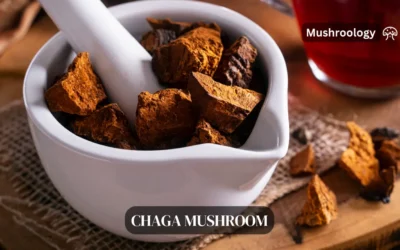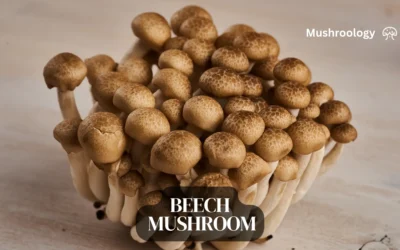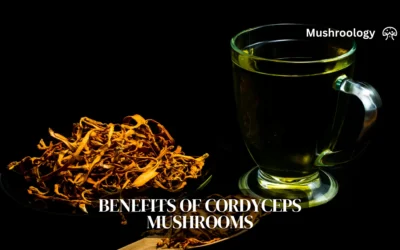Turkey Tail mushrooms (Trametes versicolor), also known as “cloud polypore” are gaining popularity due to their potential health benefits. These versatile fungi boast a beautiful fan-shaped appearance and are prized for their medicinal properties. Growing Turkey Tail mushrooms at home is surprisingly achievable, even for beginners with the right knowledge and equipment.
Choose Your Cultivation Method
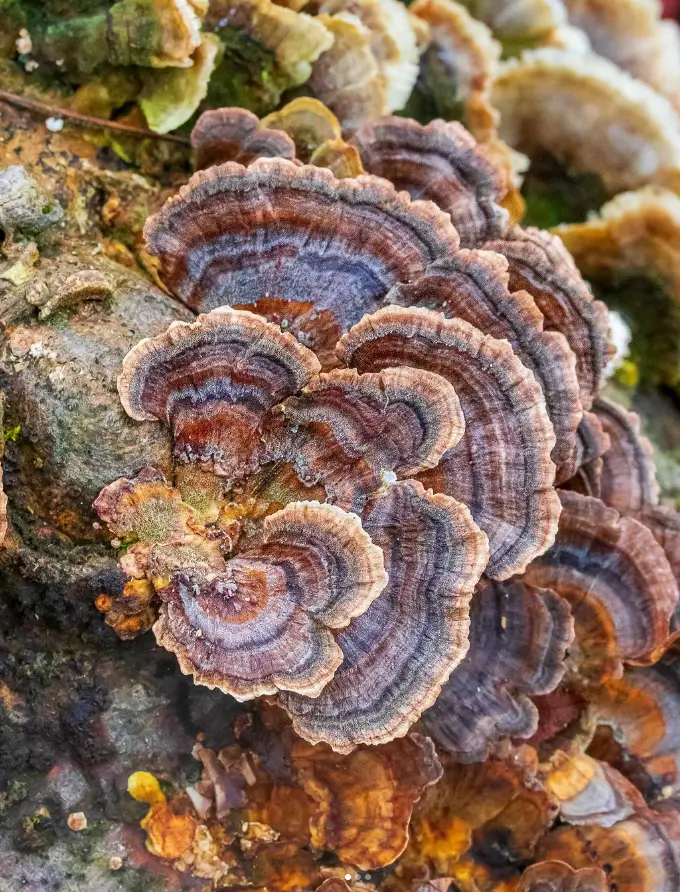
There are two primary methods for cultivating Turkey Tail mushrooms at home, each with its own advantages:
1. Use a grow kit: This beginner-friendly option provides pre-sterilized substrate inoculated with Turkey Tail spawn, simplifying the process and requiring minimal equipment. Grow kits are readily available online and in some speciality stores.
2. DIY method: This approach offers greater control over the cultivation process and allows for experimentation with different substrates and spawn types. However, it requires more equipment, sterilization procedures, and aseptic techniques to maintain a sterile environment and prevent contamination.
Grow Kit Method
1. Obtain a Turkey Tail grow kit: Purchase a reputable kit containing clear instructions specific to the brand. Choose a kit size that suits your needs and available space.
2. Prepare the grow location: Select a warm, humid, and well-lit area with indirect sunlight (around 68°F – 77°F or 20°C – 25°C). Avoid placing the kit in direct sunlight or near drafts.
3. Follow kit instructions: Each kit may have slight variations, but generally involve soaking the grow bag for a specific time, maintaining humidity by misting regularly, and following specific instructions for harvesting mature mushrooms.
4. Enjoy your harvest: Once the mushrooms reach maturity, carefully cut them at the base and enjoy their potential health benefits!
DIY Method
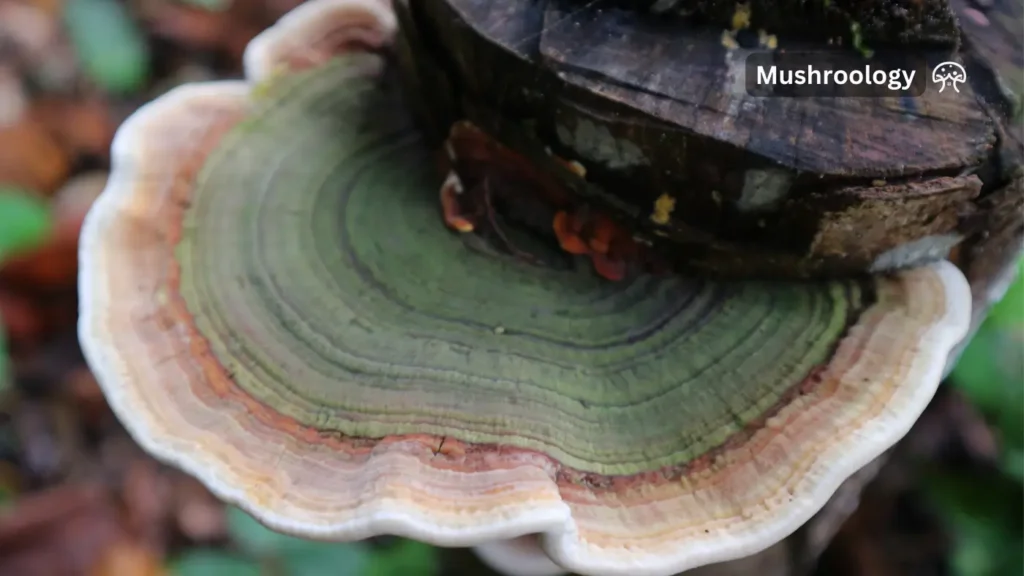
Materials:
- Pressure cooker or autoclave (essential for sterilizing substrate)
- Sterile gloves and mask (to minimize contamination risks)
- Spawn (dowel plugs, sawdust spawn, or liquid culture) – Choose a reputable source for your chosen spawn type.
- Substrate (hardwood sawdust, wood chips, or straw) – Opt for untreated hardwood materials suitable for mushroom cultivation.
- Grow bags or containers with filter patches (to allow air exchange while preventing contamination)
Steps:
1. Substrate preparation
Turkey Tail Mushroom Substrate Recipe
Growing turkey tail mushrooms requires a suitable substrate that provides the necessary nutrients, moisture, and structure for the mycelium to thrive.
Ingredients:
- Base Material: Hardwood sawdust or hardwood fuel pellets
- Supplements: Wheat bran, rice bran, or other nitrogen-rich materials
- Water
Substrate Recipe:
- Hardwood Sawdust: 78%
- Wheat Bran: 20%
- Gypsum: 1%
- Brown Sugar: 1%
- Water: 60-65% moisture content
Prepare the Ingredients
If using hardwood fuel pellets, hydrate them with water until they break down into sawdust. Measure out the required amount of sawdust.
Supplements: Measure out the wheat bran, gypsum, and brown sugar.
Mix the Substrate
In a large mixing container, combine the sawdust, wheat bran, gypsum, and brown sugar.
Gradually add water to the mixture, mixing thoroughly to ensure even distribution. The substrate should have a moisture content of 60-65%. To test this, squeeze a handful of the substrate; only a few drops of water should come out.
2. Sterilization
Pressure cook the filled containers sufficiently at the appropriate pressure to eliminate any contaminants. Refer to specific guidelines for your pressure cooker model and chosen substrate.
3. Inoculation
In a sterile environment (such as a still air box), carefully transfer the spawn to the sterilized substrate using sterile techniques. This step is crucial to prevent contamination.
4. Incubation
Seal the containers and store them in a warm, dark location (around 77°F or 25°C) for colonization. Mycelium, the vegetative network of the fungus, will gradually spread throughout the substrate.
5. Fruiting
Once the substrate is fully colonized, introduce fruiting conditions. This typically involves providing indirect sunlight, fresh air exchange (by creating small holes in the containers), and increased humidity levels (around 80-90%). Misting the fruiting chamber regularly can help maintain humidity.
6. Harvesting
When mature mushrooms appear, typically with well-developed caps and edges, carefully cut them at the base. Avoid disturbing the mycelium to allow for future flushes.
Tips for successful Turkey Tail cultivation
Here are some additional tips to enhance your chances of successfully cultivating Turkey Tail mushrooms at home:
Maintain optimal conditions:
- Temperature: Aim for a consistent temperature range between 68°F and 77°F (20°C and 25°C) during the colonization and fruiting stages.
- Humidity: Maintain high humidity levels, around 80-90%, throughout the fruiting stage. Regularly misting the fruiting chamber or using a humidifier can help achieve this.
- Airflow: Provide adequate fresh air exchange to prevent stagnation and promote healthy fungal growth. Create small holes in the grow bags or fruiting chamber for passive air circulation.
- Light: While direct sunlight should be avoided, some indirect sunlight can be beneficial during fruiting. Aim for around 12 hours of diffused light per day.
Prevent contamination:
- Sterilization: Ensure proper sterilization of all equipment and materials used in the cultivation process to minimize the risk of contamination. This is especially crucial for the DIY method.
- Cleanliness: Maintain a clean and hygienic environment throughout the cultivation process. Wash your hands thoroughly before handling any materials or mushrooms.
- Monitoring: Regularly inspect your grow kits or DIY setups for signs of mold or other contaminants. If contamination occurs, isolate and dispose of the affected materials promptly to prevent further spread.
Be patient!
- Patience: Cultivating mushrooms takes time. Be patient and allow the mycelium to colonize the substrate fully before expecting fruiting bodies to appear.
- Experimentation: As you gain experience, you can experiment with different substrates, spawn types, and fruiting conditions to optimize your results.
How to harvest turkey tail mushroom
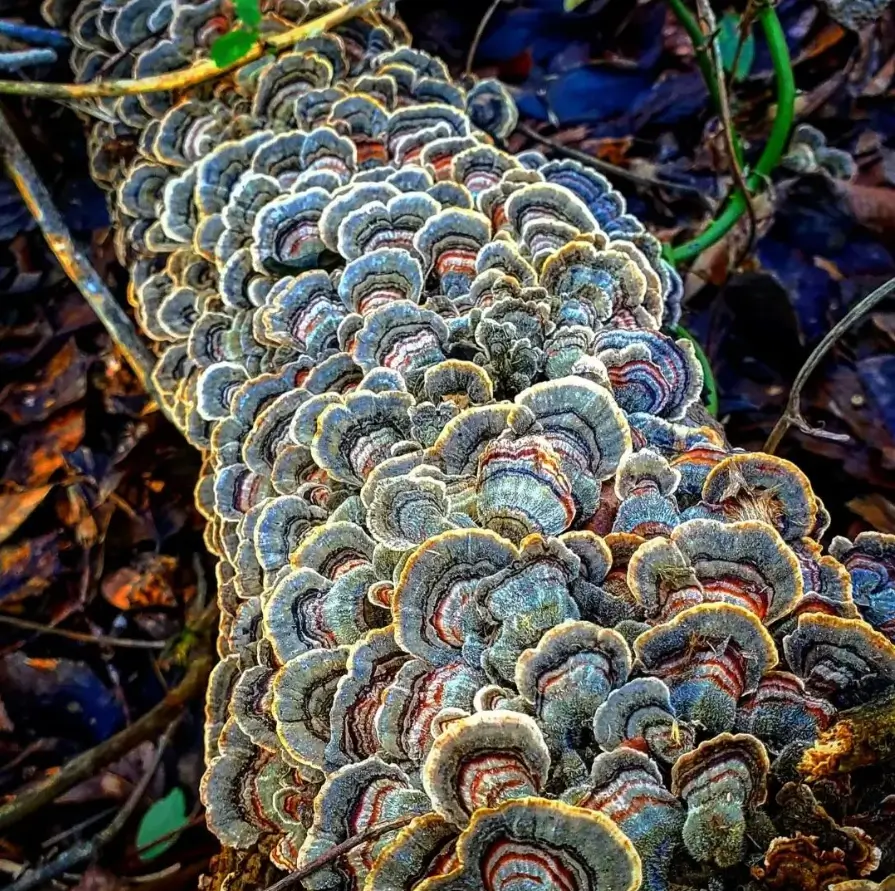
Harvesting turkey tail mushrooms involves identifying the right specimens, using appropriate tools, and following sustainable foraging practices. Here’s a detailed guide on how to harvest these mushrooms:
Before harvesting, ensure you correctly identify turkey tail mushrooms:
- Appearance: Look for fan-shaped caps with concentric color zones in shades of brown, reddish-brown, gray, or white.
- Texture: The cap should be fuzzy to the touch, not hairy.
- Underside: True turkey tails have small, almost invisible pores on the underside, which should be white or light gray.
Tools Needed
- Sharp Knife or Scissors: These tools help you cleanly cut the mushrooms from their substrate without damaging them or the host log.
Harvesting Steps
- Select Fresh Specimens: Look for vibrant, fresh-looking caps. Avoid mushrooms that are brittle, fading in color, or appear dingy, as these may be past their prime.
- Cut Carefully: Use a sharp knife or scissors to cut the mushrooms from the log or tree. Make sure to leave the base of the mushroom attached to allow for future growth and to support the ecosystem.
- Leave Some Behind: Always practice sustainable foraging by leaving some mushrooms behind. This ensures that the fungi can continue to reproduce and support the local environment.
How to clean turkey tail mushrooms
Cleaning turkey tail mushrooms is a straightforward process, but it requires some care to ensure they are properly prepared for further use. Here are the steps to clean turkey tail mushrooms effectively:
1. Inspect the Mushrooms
- Check for Insects and Mold: Before cleaning, inspect the mushrooms for any signs of insects, mold, or other contaminants. Discard any mushrooms that appear compromised.
2. Trim the Mushrooms
- Use Scissors or Shears: Trim off the edge of the mushroom that was attached to the log. This part often has the most debris and can be tough. Kitchen shears are particularly handy for this task.
3. Brush Off Dirt and Debris
- Use a Soft Brush or Toothbrush: Gently brush off any visible dirt or debris using a soft brush or toothbrush. This method is usually sufficient for cleaning turkey tail mushrooms since they typically grow on wood and not in soil, making them less dirty than ground-growing mushrooms.
4. Rinse if Necessary
- Quick Rinse Under Running Water: If the mushrooms are particularly dirty, you can give them a quick rinse under running water. However, avoid soaking them as mushrooms can absorb water and become waterlogged, which can affect their texture and drying process.
5. Pat Dry
- Use a Paper Towel or Cloth: After rinsing, pat the mushrooms dry with a paper towel or clean cloth to remove excess moisture. This step is crucial if you plan to dry the mushrooms afterward.
6. Drying (Optional)
- Dehydrator or Oven: If you plan to store the mushrooms for later use, drying is recommended. Lay the cleaned mushrooms on a drying rack or baking tray. Use a dehydrator set to 95-100°F for 24-36 hours, or an oven set to the lowest temperature with the door slightly open for about 24 hours.
How to store Turkey Tail Mushrooms
Storing turkey tail mushrooms properly is essential to maintain their quality, potency, and longevity. Here are the best methods for storing both fresh and dried turkey tail mushrooms:
Storing Fresh Turkey Tail Mushrooms
1. Refrigeration
- Container: Store fresh turkey tail mushrooms in a breathable container, such as a paper bag or a loosely covered container. Avoid plastic bags or airtight containers as they trap moisture and can cause the mushrooms to spoil quickly.
- Temperature: Place the container in the refrigerator at a temperature between 34-38°F (1-3°C).
- Moisture Control: To prevent excess moisture, place a dry paper towel or a clean cloth in the container with the mushrooms to absorb any residual moisture.
- Shelf Life: Fresh turkey tail mushrooms are best used within a week to ensure optimal flavor and texture.
Storing Dried Turkey Tail Mushrooms
1. Airtight Containers
- Container: Store dried turkey tail mushrooms in an airtight container to protect them from moisture and humidity. Glass jars or resealable bags with the air squeezed out are ideal.
- Location: Keep the container in a cool, dark place, such as a pantry or cupboard, to avoid exposure to light which can degrade the quality over time.
- Labeling: Label the container with the name and date of the dried mushrooms to keep track of their freshness.
- Shelf Life: Dried mushrooms can be stored for several years, but it is best to use them within a year for optimal flavor and potency.
2. Adding Moisture Absorbers
- Oxygen Absorbers or Silica Packets: For long-term storage, consider adding an oxygen absorber or food-safe silica desiccant packet to the container. This helps to absorb any residual moisture and keeps the mushrooms fresh.
Freezing Turkey Tail Mushrooms
1. Preparation
- Cleaning: Clean the mushrooms thoroughly and remove any dirt or debris.
- Blanching (Optional): Blanch the mushrooms by boiling them for 1-2 minutes, then immediately transfer them to a bowl of ice water to cool. This step helps preserve their quality and extend their shelf life.
2. Freezing
- Portioning: Divide the mushrooms into portion sizes that you are likely to use at once. This makes it convenient to defrost only what you need.
- Packaging: Place the portions in airtight containers, freezer bags, or vacuum-sealed bags.
- Labeling: Label each container with the name and date.
- Storage: Store the containers in the freezer. Frozen turkey tail mushrooms can be stored for up to 12 months.
Making Tinctures or Extracts
1. Tinctures
- Preparation: Steep dried turkey tail mushrooms in alcohol (such as vodka) for several weeks.
- Storage: Store the tincture in a cool, dark place away from direct sunlight. Tinctures can last for several years if stored properly.
By following these storage methods, you can ensure that your turkey tail mushrooms remain fresh and potent, allowing you to enjoy their medicinal benefits for an extended period.
Where do turkey tail mushrooms grow?
Turkey tail mushrooms are highly adaptable and can be found in a variety of environments across the globe. Here are some key details about their natural habitat:
Global Distribution
Turkey tail mushrooms are found almost anywhere in the world, including North America, Europe, Asia, and other regions. They are particularly prolific in North America and are one of the most common forest mushrooms.
Preferred Growing Conditions
Turkey tail mushrooms primarily grow on dead or decaying hardwood logs, stumps, and fallen branches. They are saprotrophic, meaning they feed on decomposing organic matter, which helps in nutrient recycling in forest ecosystems.
They are most commonly found on hardwood trees such as oak, beech, maple, and birch. Occasionally, they can also grow on coniferous trees like fir and pine.
These mushrooms can grow year-round, but they are most noticeable and abundant in the autumn and winter months when they release their spores.
Ecological Role
Turkey tail mushrooms play a crucial role in breaking down tough materials in wood, returning nutrients to the soil, and maintaining forest health.
They cause white rot in the wood they colonize, which helps decompose lignin and cellulose, the primary components of wood.
Identification
Turkey tail mushrooms are recognized by their multicolored, concentric zones on the cap, which resemble a turkey’s tail feathers. The underside of the cap is white and porous.
They often grow in groups, rows, or clusters, forming layered structures on the wood.
Foraging Tips
When foraging, look for them on the trunks of downed trees, dead stumps, or branches in deciduous forests. They are relatively easy to find due to their distinctive appearance and widespread presence.
Ensure proper identification by checking for the characteristic multicolored bands and white porous underside to avoid confusing them with lookalikes such as the false turkey tail (Stereum ostrea).
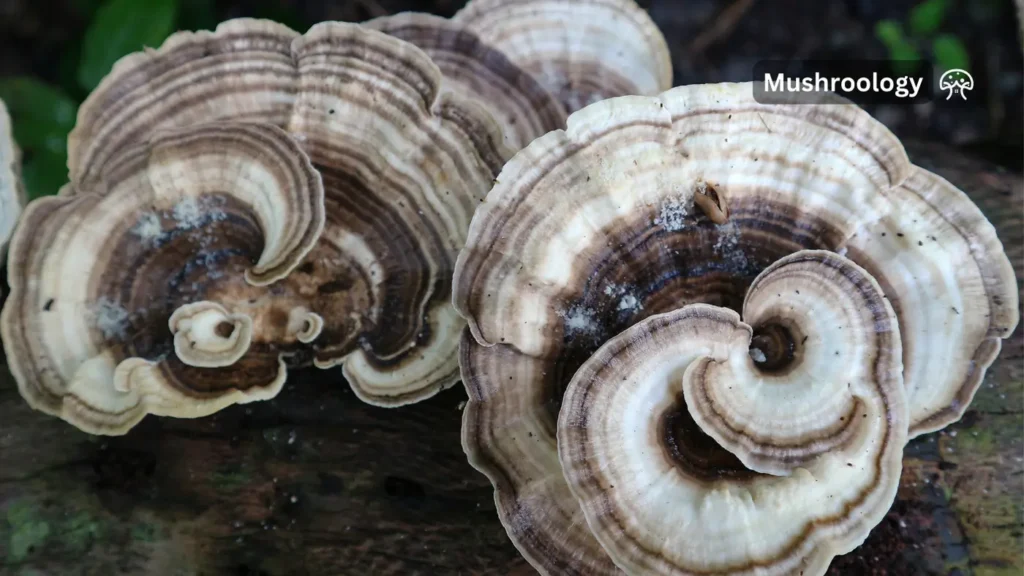
FAQs About Turkey Tail Mushroom
- What is turkey tail mushroom?
Turkey tail mushroom (Trametes versicolor) is a type of medicinal fungus that grows on dead logs and trees worldwide. It gets its name from the colorful stripes on its cap, which resemble the tail feathers of a wild turkey. It has been used in traditional medicine for centuries, particularly in Asia.
2. What are the potential health benefits of turkey tail mushroom?
Turkey tail is rich in antioxidants and polysaccharides, such as PSK (polysaccharide-K) and PSP (polysaccharide-peptide), that have been studied for their potential benefits on the immune system. Research suggests it may help boost the immune response in people with certain cancers when used alongside conventional treatments like chemotherapy. Additionally, it is being studied for its potential role in gut health and fighting infections.
3. How is turkey tail mushroom consumed?
Turkey tail is typically consumed as a supplement in capsule or powder form, or as an ingredient in teas and soups. It is not typically eaten as a culinary mushroom due to its tough texture.
4. Are there any side effects of turkey tail mushroom?
Turkey tail is generally considered safe for consumption, but some people may experience mild side effects such as upset stomach, nausea, or darkened stools. It’s essential to consult with your doctor before taking turkey tail supplements, especially if you are pregnant, breastfeeding, or have any underlying health conditions.
5. Where can I buy turkey tail mushroom?
Turkey tail mushroom supplements can be found at health food stores, pharmacies, and online retailers. It’s important to choose reputable brands that offer high-quality, pure extracts.
6. What is the best way to grow turkey tail mushrooms?
The most common and effective way to cultivate turkey tail mushrooms is on hardwood logs, such as oak, maple, or beech. You can also grow them on supplemented sawdust blocks or even indoors using grow kits.
7. What are the ideal conditions for growing turkey tail mushrooms?
Turkey tail mushrooms thrive in a shaded and humid environment. They prefer temperatures between 18-24°C (64-75°F) and high humidity levels. Proper ventilation is crucial to prevent mold growth. Logs should be kept moist but not waterlogged.
8. How long does it take to grow turkey tail mushrooms?
The time to fruiting for turkey tail mushrooms can vary, but it usually takes about 6-12 months for the mycelium to colonize the substrate and produce mushrooms. The timing can be affected by factors like temperature, humidity, and the type of substrate used.
9. How do I know when turkey tail mushrooms are ready to harvest?
Turkey tail mushrooms are typically ready to harvest when the edges of the fruiting bodies start to turn brown or when the mushrooms become brittle and dry. Harvesting at this stage ensures that the mushroom has reached its peak potency for medicinal purposes.
10. Can I grow turkey tail mushrooms indoors?
Yes, you can grow turkey tail mushrooms indoors using grow kits available from various suppliers. These kits typically contain a pre-colonized substrate, like sawdust or wood chips, and instructions for creating the ideal growing conditions indoors.



